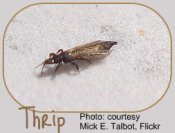- Home
CARE for your HOUSE PLANTSGROWING HOUSE PLANTSCHILDREN & PETS & PLANTSGIFTS for the INDOOR GARDENERSCIENCE of HOUSE PLANTSSITE LOGISTICS- Tell your story
|
Thrips
Info for the Indoor Gardener
Wondering what to do if your houseplants are attacked by thrips? Below the Google ads the Indoor Gardener can learn how to identify and eradicate these common garden pests.
DESCRIPTION
- thrips are alligator shape: long and narrow
- very tiny: 1/16th - 1/8th inch
- some sources say as small as 1/25th inch
- most have wings
- fringes on wings
- short antennae
- females usually larger than males

LOCATION
- hide in buds of flowering houseplants
- they like dark parts of the plants
- attracted to water and moisture
- favorite houseplants:
- arrowhead vine
- dieffenbachia
- ficus
- hibiscus
- mother-in-law's tongue
- philodendron
- schefflera
- zebra plant
- Franliniella occidentalis prefers African violets
MULTIPLICATION
- fly to nearby house plants
- can be blown by fan, wind
- also spread by crawling, jumping
- up to 8 generations/year
DESTRUCTION
- puncture plant
- suck nutrition from leaves, sometimes stems
- slows growth
- can transmit fungal and viral plant diseases
- sources disagree whether or not species of this garden pest are plant-specific
- sting people and pets: can cause itching or rash
DETECTION
- very hard to find
- use a magnifying glass
- shake branches over white paper to detect
- use yellow or blue sticky traps
- they can be found hopping along the soil surface
- leaves appear misshapen or curled
- brown edges at times
- scarring on leaves
- leaf can appear with stripes or spotting
- upper layer of leaf can be dead
- silver or white scarring present
- black feces spot present
- leaf may become lacelike
- flower petals have spots that are pale or dark
- leaves drop off
SOLUTION
Since some species of these garden pests are beneficial, be sure to identify your thrips before trying to control them.
- isolate plant immediately, moving it slowly away from other houseplants
- use systemic insecticides
- chemical sprays: Acephtate, Malathion, Diazinon, Carbayl, Methoxychlor (follow directions)
- some sources advise against Malathion use as not effective and encourages increase in spider mites
- horticultural oils: azadriachtin, neem oil, permethrins with piperonyl butoxide
- insecticidal soaps
- garlic oil
- every 2-3 days mist infected plants or gently wash off - repeat for at least 4 weeks
- foliar pesticides - every 5-days
- mist with a drop of pine oil in water
- cut off branches where thrips are detected
- use dichlorvos strip and cover plant with plastic bag for 24 hours
- Natural Predators for use in greenhouse or conservatory:
- Megaphragma mymaripenne
- Thripobius semiluteus - parasitic wasp
- Orius insidiosus - pirate bugs
- Amblyseius cucumeris - predator mite
- Neoseiulus mackanziei - predator mite
- Iphiseius degenerans - predator mite
- Hypoasis miles - predator mite
- Chrysoperla - green lacewings
- Damsel bugs
For Botanists, Scientists, Outdoor Gardeners, and School Reports
Not all thrips are garden pests. Black hunter and six-spotted thrips are beneficial, feeding on fungal spores or pollen. Some species eat up pest thrips as well as spider mites
- Order: Thysanoptera
- Suborders:
- Terbrantia
Family: Thripidae (destructive species in this Family)
- Tubulifera
Family: Phlaeothripidae
- worldwide about 5,000-6,000 species
- U.S. and Canada - about 265 species (not counting predator thrips)
- 100s of varieties
- Beneficial Species:
- Franklinopthrips orizabensis
- Franklinopthrips vespiformis
LIFE CYCLE:
- Females do not need to mate to lay eggs
- Unfertilized females lay only male eggs
- Mated females lay eggs of both genders
- Female "ovipositors" cut slits in leaves or buds
- 25-50 eggs are laid in these channels
- Eggs are narrow, long, large
- Eggs hatch in 2 days - 1 week
- Two nymph stages in which they feed (lasts about 1 week)
- Larvae are wingless
- Prepupae and pupae stages fall off leaves and grow in soil
- Prepupae stage about 1-2 days
- Pupal stage is non-feeding; not true pupal stage (lasts 1-3 days)
- About 8 generations/year
- Egg to adult - about 2 weeks (depends on moisture and temperature; can take up to 3 weeks)
- Adults live 1 - 1-1/2 months
DISCLAIMER: The Indoor-Gardener.com provides information through data research and personal experience and does not mean to recommend or refute any product used for insect control inside or outside the house. Read and follow instructions carefully as listed on all products. Indoor-Gardener.com is not responsible for use of any product or method described on these pages, nor for any possible adverse affects of such use. The legal use of chemicals for plant health can change, and it is solely the responsibility of the user of such chemicals to remain in compliance with such laws. Indoor-Gardener.com and Batya D. Wininger assume no liability resulting from the use of any information on these pages. While this website does its best to provide only the best, up-to-date information to its visitors, there can be changes and mistakes. Read labels carefully and follow instructions for use.
Back to Top of Page
Return to Garden Pests
Return to Home Page
|
|
|








